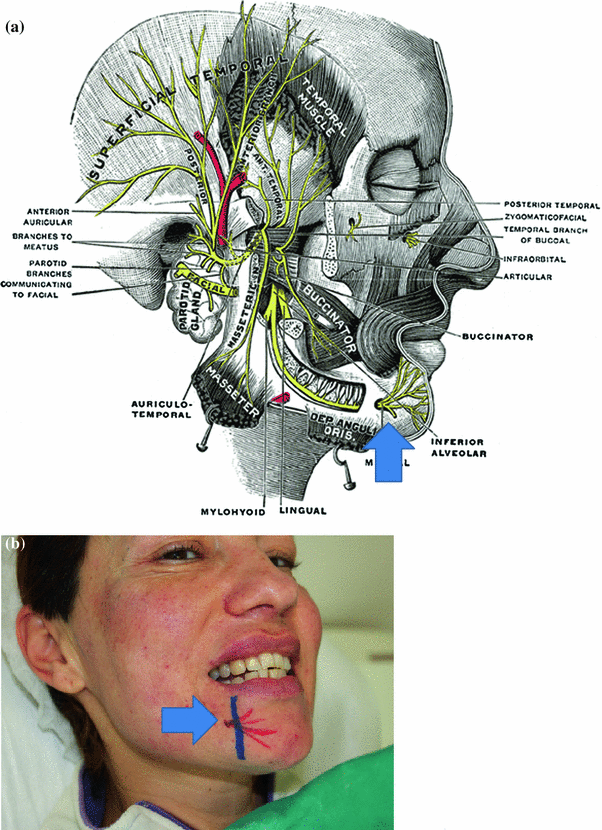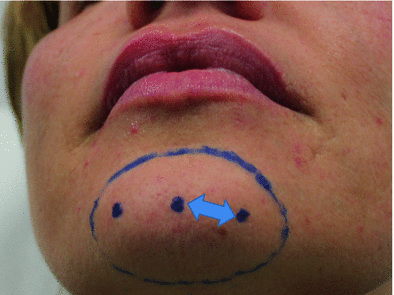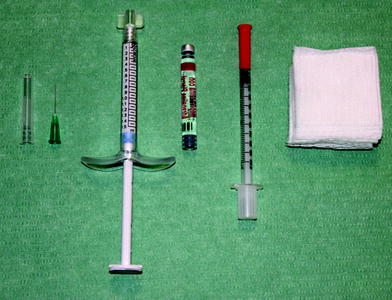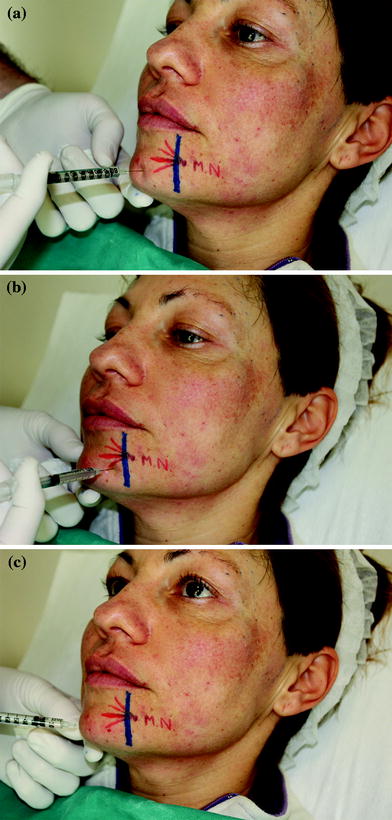Fig. 12.1
Bone anatomy of the chin
Noble structures that are located in chin area and need to be preserved during the treatment are as follows:
The inferior alveolar nerve (sometimes called the inferior dental nerve) is a branch of the mandibular nerve, which is itself the third branch (V3) of the trigeminal nerve (cranial nerve V) (Fig. 12.2a, b).


Fig. 12.2
a, b Inferior alveolar nerve indicated with the arrow. a Reproduction of a lithograph plate from Gray’s anatomy (Henry Gray, Anatomy: Descriptive and Surgical)
Anteriorly, the nerve gives off the mental nerve at about the level of the mandibular 2nd premolars, which exits the mandible via the mental foramen (supplying sensory branches to the chin and lower lip).
12.2 Pitfalls
The noble structures can be preserved using the correct point of injection (safe point). Identification of the mental nerve prevents damages to the nerve itself which would lead to anaesthesia and paraesthesia of the inferior lip.
The nerve can be easily identified by palpation of the mental foramen that is placed 1 cm superiorly to the inferior mandibular border between the first and second premolar.
Injecting filler in the mental area, we recommend to use three points of injection: the centre of the mandibular symphysis and, for each side, a point placed medially to the mental foramen and around 1 cm laterally to the centre of the symphysis (Fig. 12.3).


Fig.12.3
Three safe points where to inject; the blue arrow indicates the 1 cm distance between the central and the lateral point
12.3 Augmentation of the Chin
Chin augmentation can lead to substantial improvement in the appearance of the face, giving a better look to the patient. It can correct the chin reduction due to age, and it can ameliorate the sagging of the neck. It is useful to create a camouflage of facial asymmetry, and it can augment the dimension of the lower third of the face in second-class patients.
Augmentation of the chin is a simple procedure, carried out in the office under local anaesthesia. Few noble structures need to be preserved, but this can be accomplished simply.
12.4 Augmentation of the Chin with Calcium Hydroxylapatite
12.4.1 Indications
Asymmetries, second-class patient, ageing.
12.4.2 Contraindications
Anatomical alterations due to precedent trauma or surgical intervention (maxillofacial surgery). In fact, scarring and presence of internal fixation often induces a displacement of the structures that can lead to asymmetry and unequal filling of the part treated. Presence of surgical implants (previous chin augmentation with silicone implants, etc.) in fact, infection of the surgical implant after filler infection can result in surgical removal.
No injection should be done if the area has been previously treated with liquid silicone or other permanent fillers because new injection could lead to inflammation or infection of the implants.
Any hypersensitivity to any components of the filler obviously constitutes a contraindication for the treatment.
12.4.3 Operating Time
The procedure usually takes from 10 to 15 min.
12.4.4 Materials
1.5 cc of Calcium Hydroxylapatite.
Needle 28 g, 13 mm length.
0.2 cc of Local anesthetic (2 % Lidocaine, 2 % mepivacaine) with epinephrine 1:100 000.
12.4.5 Material Choice
In Europe, Asia, and America, Radiesse can be used.
12.4.6 Methods
Procedure is described in Figs. 12.5a–c, 12.6, 12.7a, b.











